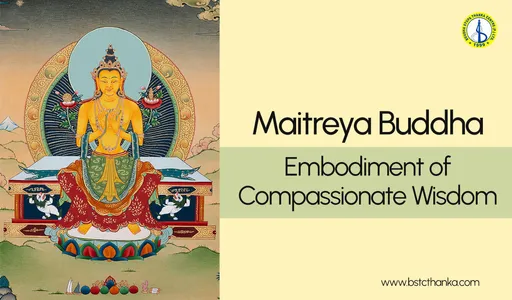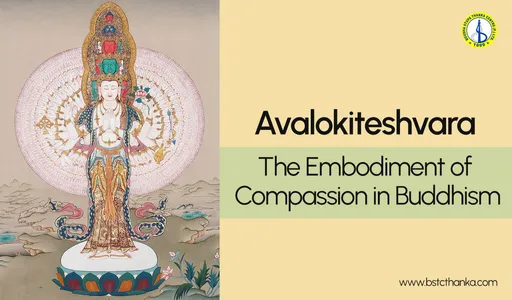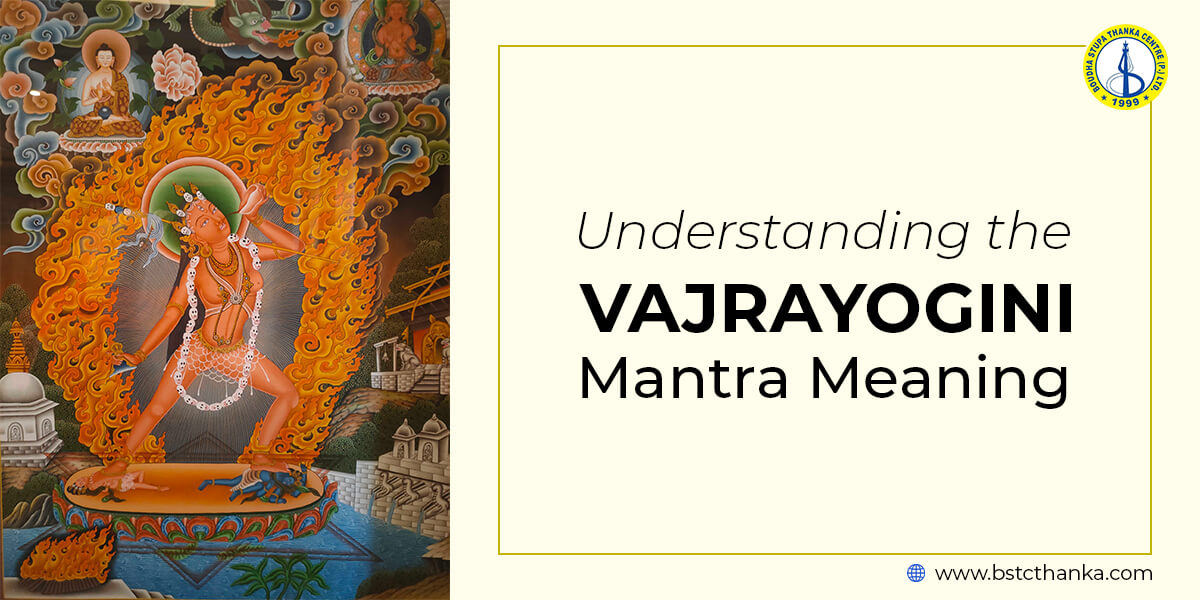
The Vajrayogini Mantra: Benefits, Practice, Empowerment
The Vajrayogini Mantra: Benefits, Practice, Empowerment
The Vajrayogini is a tantric deity in Buddhism who represents the path that leads to female Buddhahood. She is regarded as the goddess of grace as well as destruction as she destroys the illusions of the ego.Vajrayogini is a 16-year-old female dakini embodying divine wisdom. She is a feisty manifestation of the divine feminine.
There are several representations of Vajrayogini, but she is mostly depicted as a young and naked tantric deity, blood red (representing her inner fire), wearing ornaments of the human skeleton, a necklace of skulls(representing 16 vowels and 32 consonants that symbolizes purity of speech).
She stands fiercely, holding a flaying knife (vajra) in her right hand, using it to cut off all attachments. In her left hand, she holds a skull cup filled with mahasukha(eternal bliss); she pours these out to her devotees with compassion. She is surrounded by beaming flames of awareness. She looks up towards the pristine realm of Khechara and drinks from the skullcap on her left hand.
Practices related to Vajrayogini and the Vajrayogini mantra are often kept a secret, as anyone with limited knowledge can easily misinterpret it. The Vajrayogini practice is a sacred practice which requires guidance . If these practices are misinterpreted then the practitioners will have to face the severities including ; health issues, mental disturbance and spiritual regressions as well.
Vajrayogini Short Mantra
oṃ va jra yo gi nī hūṃ pha ṭ svā hā
oṃ vajrayoginī hūṃ phaṭ svāhā
This Vajrayogini mantra holds immense significance in Tibetan Buddhism. It comes from Anuttara Yoga tantra and should be recited with proper guidance and instructions. Like any other Tibetan Buddhist mantra; this Vajrayogini mantra can be a powerful tool for self-transformation, healing and liberation from samsara. This mantra is especially beneficial for women as they can relate more to the female deities.
Understanding the Vajrayogini Mantra Meaning
om om om sarva buddha dakiniyé benza warnaniye benza bairotsaniyé hung hung hung phat phat phat soha
oṃ va jra yo gi nī hūṃ pha ṭ svā hā
oṃ vajrayoginī hūṃ phaṭ svāhā
According to the Vajrayarahi tantra, after understanding this mantra, if one recites it 36 times every day, they can benefit from this not only in this lifetime but at the bardo state and lifetimes after that as well.
Each syllable and word in this mantra holds meaning and significance. Let's dissect them to get a better understanding.
OM- Om is a sacred syllable regarded as the universal sound. Om is indicative of the nature of the consciousness or the ultimate reality.
Vajrayogini: Vajrayogini is a fierce goddess embodying divine wisdom.
Hum-Hum is a seed syllable that is associated with Vajrayogini. This syllable is indicative of essence and her power. This is used to invoke her presence and blessings.
Phat-Phat is a dynamic syllable used as a shield against negative forces and dispels obstacles along the way.
Svaha: This is a commonly used syllable in Buddhism and Hinduism. This is used to seal the mantra and make an offering towards the deity while expressing one’s dedication and surrender.
All the mantras and practices related to Vajrayogini are often regarded as a secret and should not be chanted without instruction. Vajrayogini mantras are widespread all over the internet today, but you should not risk chanting these without proper guidance from a Guru.
Explore Our Vajrayogini Thanka Artwork.
Benefits of Vajrayogini Practices
The Vajrayogini practices have miraculous benefits. Hence they are widely spread all over the internet. Although these practices are one click away and are free of cost, one should not practice this sacred meditation and chant the mantras without initiation. If you are not initiated into the practice or Vajrayogini mantra but still want to reap the benefits, you can take the path of offerings, prayers, and praise towards Vajrayonini.
According to the source tantra, in the condensed root tantra of Heruka, there are 10 key benefits of the Vajrayogini practices. We have elaborated on each one in detail below.
Easy To Practice
Even though the Vajrayogini practice is regarded as the highest Yoga tantra practice, it is relatively easier. The Vajrayogini mantra is quite short, and the mantra is also easy to recite.
Ideal For Degenerate Times
As we discussed earlier, the Vajrayogini practice is ideal for modern times, also regarded as the “degenerate times.” These practices aim to resolve modern problems and go with fast-paced schedules.
Supreme For Attainments
Even though it is a long mantra, it is quite easy to memorize. This practice is all you ever need if you have the necessary faith. This practice is all you ever need if you have the necessary faith. The Vajrayogini mantra has 32 long syllabi, and the 32 syllabi represent the 32 Dakinis of her mandala and their good deeds.
Can Accomplish All Attainments
Several Mahasiddhas have attained enlightenment and other profound realizations with the Vajrayogini practice.
Can Practice Both The Completion and Generation Stages Together
Most Buddhist practices require you to perfect the generation stage before you engage in the completion stage. However, with the Vajrayogini practice, you can perform the generation and completion stages together. Guru’s guidance is helpful if you don’t understand what this means.
Overcome Attachment
The Vajra yogini practice helps individuals control their desires and practice non-attachment. Vajrayogini holding a knife in her hand is symbolic of her cutting the roots of all attachments.
Essence Of All Practices
The Vajrayogini Practice and Vajrayogini mantra comprises the essence of all the other practices. Even though it is a brief practice, it carries the essence of other practices.
Powerful Blessings
Practising Vajrayogini meditation not only attracts blessings into your life but attracts them quicker.
The other two benefits are quite secretive. Unless you are a practitioner, it is difficult for you to understand. So it is inappropriate to discuss them in detail. But we have listed them out for your reference.
- Uncommon Yoga of Inconceivability
- Special body mandala practice
Vajrayogini Practice In Buddhism
Vajrayogini practice is a well-cherished practice in Vajrayana Buddhism. Vajrayogini practice is regarded as the highest yoga tantra that requires guidance, empowerment, and initiation.
A qualified guru is a prerequisite if you are willing to participate in the Vajrayogini practices.
Several great Mahasidhhas, like the Naropa, Indrabodhi, Maitripa have attained enlightenment through her practices.
Vajrayogini is regarded as the “Budhha of our times” because her practices offer ways to navigate modern challenges while delving deep into body and mind. These practices are suitable for the hectic schedules of these degenerate times.
Vajrayogini Empowerment
To receive any major sacred empowerment in Vajrayana Buddhism, one must complete the preliminary practices or the Ngondro. If you have time, you should opt for a retreat because, in a retreat, the completion of the Ngondro happens in 3-6 months, while it may take 6 years if you practice this for a couple of hours every day.
After the completion of Ngondro, the practitioner must receive either Hevajra orChakrasamvara’s empowerment and complete six yogas of Naropa. Only then can they proceed further in practicing Vajrayogini empowerment.
Vajrayogini Meditation
Vajrayogini meditation is a compilation of complex and advanced practices, including recitation of mantras, intricate visualizations, offerings and integration into daily life. Unlike any other meditation practice, the Vajrayogini meditation is a very energetic practice and is suitable for the fast paced lives we live in today’s time. The Vajryogini meditation is also regarded as the body, speech and mind meditation. This meditation is designed to eliminate ignorance and hatred. Vajrayogini meditation is a relatively easier practice and is accessible to anyone who is willing and persistent.
Vajrayogini meditation should be performed under the guidance of a qualified Guru who is well-versed in Vajrayana practices. These practices hold immense depth and intricacy. Vajrayogini tantra practice is considered the fastest way to achieve Nirvana.
Vajrayogini Day In 2023, 2024, 2025
Vajrayogini Day or Dakini Day is allocated to celebrate the wisdom of feminine energy. The 11th Lunar Tibetan month is highly encouraging for all the Vajrayogini practices The 25th day of this lunar month is regarded as Vajrayogini Day. This is a powerful time for practicing the Heruka practices as well.
In 2023, Vajrayogini Day is on the January 17th
In 2024, Vajrayogini Day is on the January 6th
In 2025, Vajrayogini Day is on the January 25th
Origin And Lineages Of Vajrayogini
Vajrayogini Practice originated anywhere between 10th to 12th centuries in India. Vajrayogini practice happens in two stages; Generation and Completion stage. These stages were originally taught by Vajradhara. It is believed that Vajradhara manifested in the form of Heruka and spread the Vajrayogini practices through the root tantra of Chakrasamvara.
There are several form of Vajrayoginis present in different schools of Tibetan buddhism. However these 3 Lineages are most commonly practised in Vajrayana Buddhism:NaraKacho Lineage, MaitriKacho Lineage, IndraKacho Lineage.
NaraKacho Lineage
Narakacho is one of the most practised lineage amongst all. This lineage was transmitted directly from Vajrayogini to Naropa, hence the name NaroKacho Lineage. Naropa attained the profound realization and became an authoritative mahasidhhas in India.Marpa was the very first lineage hier of Naropa . The lineage continued with Marpa’s great disciple, Milarepa.
Narakacho Vajrayogini is one of the most widely used depictions of the Vajrayogini. She is seen standing in a simple posture with her left knee bent a little. She stomps both her foots over maha ishvara. Holding a curved knife with her right hand,she balances a khatvanga on her left shoulder. She drinks from the skull cap in her left hand while facing towards the sky.
MaitriKacho Lineage
This Lineage was transmitted directly from Vajrayogini to Maitripa, hence the name Maitrikacho Lineage. It is also referred to as Uddhapada Vajrayogini Lineage. Maitripa was once a monk student who later became highly accomplished in Buddhist tantric system and was famous for passing down the lineage.
Uddhapada Vajrayogini portrays a yogic posture where her right leg is bent at the knee right behind her. She is seen holding a skullcap with her left hand while her left leg is held up against her chest. Her right hand is flung out holding a curved knife. Her right hand rests just above her right foot while she balances a khatvanga on her left shoulder.
IndraKacho Lineage
IndraKacho lineage is the oldest lineage amongst all the lineages. This Lineage was transmitted directly from Vajrayogini to Indrabodhi, hence the name Indrakacho Lineage. Indrabodhi was a king who ruled Sambhola. He practised the sadhana for about 12 years and finally attained enlightenment. It is said that Indarbodhi levitated above his throne for about 7 days and on the 8th day he transcended to Kechara paradise with his 700 disciples.
Vajrayogini in her IndarKacho form is portrayed in dynamic posture of one of the greatest Vajra dance. She stomps one of her foot on maha ishvara, this illustrates the ignorance while her other leg is raised forming a dance step. She holds a curved knife with her right hand. At the level of the heart space, she holds the skull cap with her left hand. In some depictions, a sow protrudes from her right ear while it protrudes from her crown in others. This sow is representative of transmuting the great ignorance into the experience of great bliss or Nirvana.
11 Yogas Of Vajrayogini
These 11 yogas of Vajrayogini are composed of the most concise yet highest yoga tantra practices. We have curated an elaborative list of these auspicious yogas in detail.
Sleeping Yoga: Sleeping while maintaining the visualization of Vajrayogini
The first of the eleven yogas is the Sleeping Yoga. To practice this Yoga, you need to follow the upcoming steps. As you sleep at night, visualize yourself as Vajrayogini, your face and two arms in the double tetrahedral mandala.
As you lie down, visualize your head in Guru Vajradharma’s lap. Sleeping like this will provide you with a wholesome sleep, free of anger, desire and attachment.
Rising Yoga: Waking, still in the form of Vajrayogini
The next step is Rising Yoga. Upon rising in the morning, imagine the sounds of the Damarus and Vajrayogini mantras waking you up. This mantra is known as the “three om mantra.”
Imagine the mantras and sounds created by the Dakinis of three adobes coming from a clear light. Even as you progress through the day, keep visualizing yourself as Vajrayogini. This act of mindfulness makes these activities more virtuous.
Experiencing Nectar Yoga: tasting the nectar after rising.
The third Yoga is the Yoga of tasting the nectar after rising. This nectar could be any drink and should be in a vessel with a lid. Here, you must dissolve a nectar pill blessed by a qualified lama. Then, place this vessel in your right palm.
Using the ring finger of your left hand, draw three dots of a triangle representing tetrahedral. Do so while reciting OM AH HUM. While uttering the sound OM, touch the base of your palm. While chanting AH, touch the right side, and while chanting HUM, touch the left side.
Now, dip your finger at the vessel's center and visualize taking the essence of this inner offering. Now, place a drop of this nectar on your tongue and visualize yourself experiencing eternal bliss and nothingness.
The Yoga of the Immeasurables
Next comes the Yoga of the immeasurables. This Yoga includes practices that cultivate the four immeasurables as per Mahayana Buddhism. The four immeasurables are Loving-kindness (Metta), Compassion(Karuna), Empathetic Joy(Mudita), and Equanimity(Uppekkha).
Practitioners meditate on these qualities by focusing on themselves, and it gradually extends and includes all sentient beings without discriminating. The ultimate purpose of this meditation is to reduce suffering and cultivate qualities that lead to Nirvana.
The Yoga of the Guru
The next Yoga is the Yoga of the guru. Guru holds immense significance in any Buddhist practice. He is regarded as the Vajradharma. To practice this Yoga, you must focus between your eyebrows and visualize a space ahead.
Imagine a throne that is made out of jewels and is protected by 8 Lions. On that throne lies a lotus pedestal, and above that lies a moon disc. Visualize your root guru(Who you attained initiation of the Vajrayogini practice) seated on this pedestal at a distance of one full prostration from you.
Now, focus on one form of Vajradharma, recite refuge and bodhicitta, and take the bodhisattva vows. After reciting this three times, the guru dissolves into a red light and enters the crown of your head.
He dissolves in your body with much compassion and gets to your heart. He then transforms into an aspect of a red syllable BAM. Now, visualize your guru’s mind and your mind becoming inseparable. This is the end of the fifth Yoga.
The Yoga of Self-Generation
The 8th Yoga is the Yoga of self-generation. This is regarded as an advanced practice and is mostly taught by qualified gurus with necessary empowerments, transmissions and teachings. As the name suggests, The Yoga of Self Generation is a mediation practice in which the meditator visualizes themselves as the deity Vajrayogini.
This practice includes intricate visualization methods that help the practitioner acknowledge the inseparability between their true nature and the enlightened nature of the Vajrayogini.
The Yoga of Purifying Migrators
The 7th Yoga is the Yoga of purifying migrators. To do this Yoga, you must visualize yourself as the Vajrayogini emanating red light. Imagine this light filling your entire body and overflowing outside in all possible directions. This red light touches all sentient beings purifying them from head to toe, establishing them in paradise. This is a powerful form of Yoga.
The Yoga of Being Blessed by the Heroes and Heroines, including a special Body Mandala
The 8th Yoga is the Yoga of Being Blessed by the Heroes and Heroines, including a special Body Mandala. In Vajrayana Buddhism, heroes and heroines represent enlightened male and female deities who guide the practitioners on their spiritual path.
The practitioner visualizes these deities as a form of meditation and seeks their blessings and guidance to progress in their spiritual journey. These practices include Vajrayogini mantra recitations, ritual offerings and several meditation techniques.
Yoga of Verbal and Mental Recitation of the Holy Mantra
The Yoga of verbal and mental recitation of the holy mantra is a common practice in Vajrayana Buddhism. The mantra recitation is a crucial aspect of several Vajrayana practices, including the renowned Vajrayogini practice.
Yoga of Verbal and Mental recitation of the holy Vajrayogini mantra is practiced in conjunction with visualization and meditation. The motive behind the verbal and mental recitation of the mantra is to connect to the essence of Vajrayogini and invoke her blessings.
The holy mantra is “oṃ va jra yo gi nī hūṃ pha ṭ svā hā oṃ vajrayoginī hūṃ phaṭ svāhā”. This mantra cultivates a sense of connection and alignment with the enlightened qualities and blessings of Vajrayogini.
The Yoga of Inconcievability
The 10th Yoga is the Yoga of inconceivability. The term “inconceivability” specify the ultimate truth that cannot be fully comprehended by ordinary conceptual thinking. The Yoga of inconceivability involves practices and meditations designed to push beyond the limitations of ordinary perceptions.
These practices include several visualization techniques, rituals, and mediation techniques that cultivate profound realizations and eventually attain enlightenment.
The Yoga of Daily Activities
The 11th Yoga is the Yoga of daily activities. This technique involves intricate visualizations. Here the practitioners meditate on Vajrayogini’s form, attributes and symbolisms. Here the practitioners perceive everything as interconnected; they infuse this wisdom into their daily activities. The essence of Vajrayogini's practice is letting go of the attachment and perceiving everything as interconnected to cultivate compassion.
Meditators practice non-attachment and compassion with mindfulness and visualization techniques in their day-to-day activities. This is the gist of the Yoga of daily activities.
Conclusion
In Vajrayana Buddhism, the Vajrayogini mantra and practices are significant for paving a path toward profound realizations and enlightenment. Vajrayogini exudes fierce compassion and offers dramatic transformations.
The 11 yogas of Vajrayogini sum up the essence of her teachings. These practices can be used as the tool for self-discovery and transformations but can only be done under the guidance of a Guru. These profound and powerful teachings demand utmost respect and sincerity.



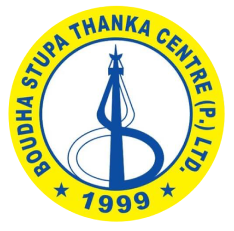
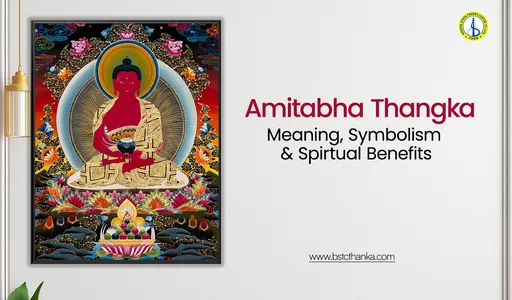
.webp)
